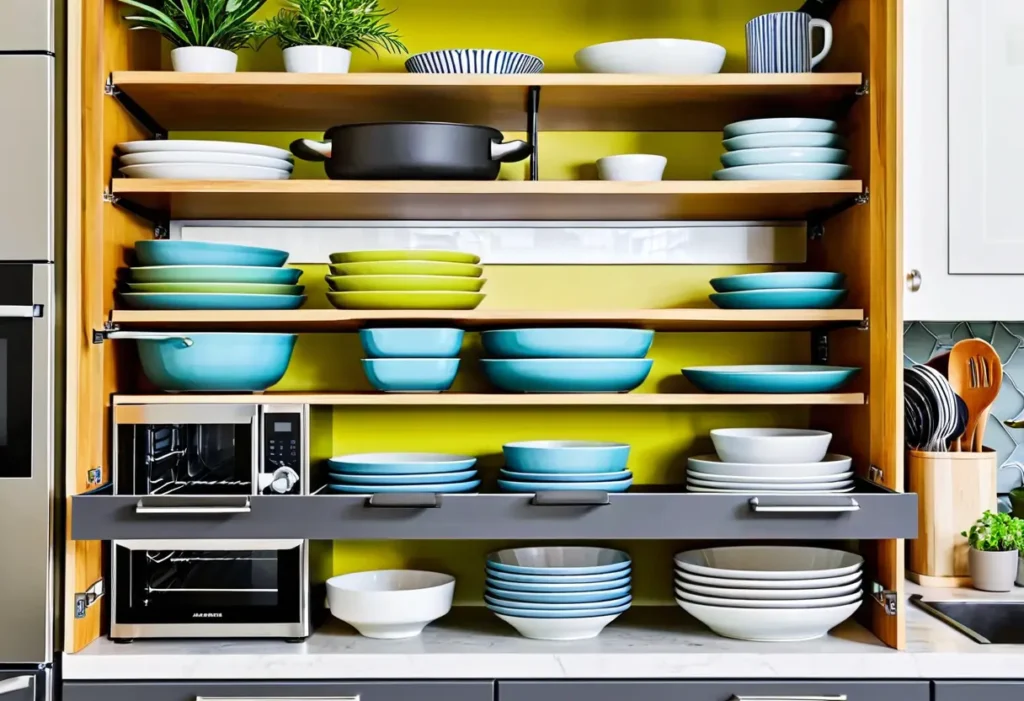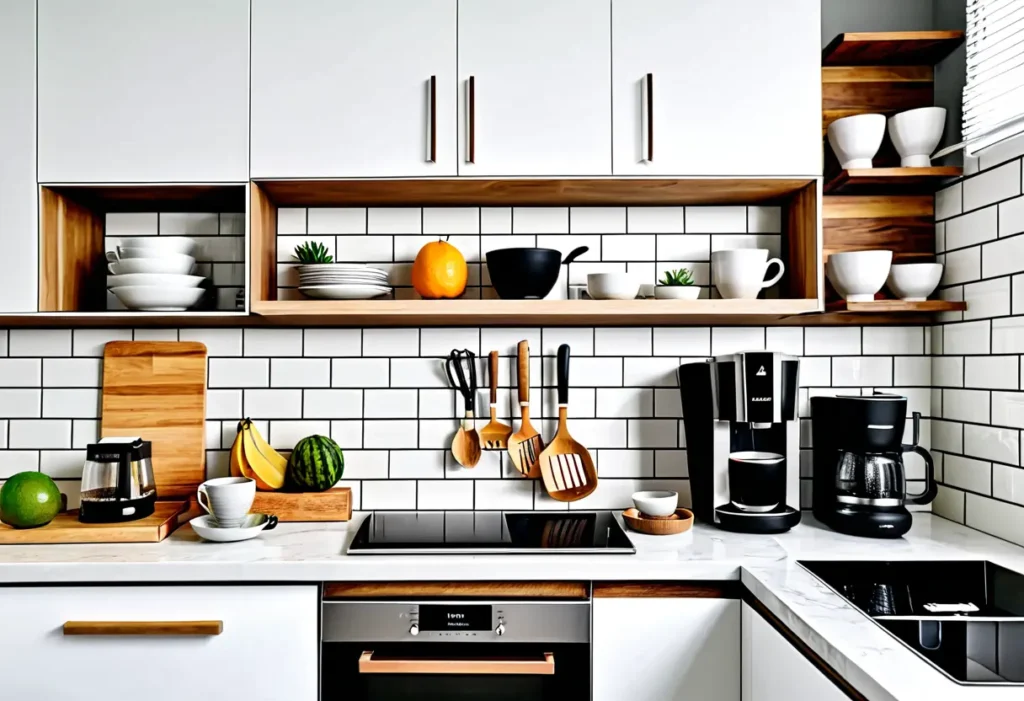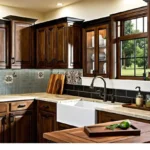If your kitchen is filled with piles of dirty dishes, cluttered cabinets or counters, don’t worry; you are not alone. Living rooms and bedrooms usually do not attract as much attention as kitchens do, and they can gather a lot of mess. Knowing how to organize a cluttered kitchen can save you time, reduce stress, and make cooking a more enjoyable experience. Whether you have a small kitchen or a large one, these practical strategies will help you reclaim your space and turn it into a functional, organized haven.

Related – 17 Brilliant Kitchen Appliance Garage Ideas
Why Kitchen Organization Matters
Before diving into the practical tips, it’s essential to understand the impact of a well-organized kitchen. When everything has a place and clutter is minimized, you’ll spend less time searching for items and more time enjoying cooking. A streamlined kitchen reduces food waste, improves safety, and creates a cleaner, more inviting space. Plus, an organized kitchen is easier to maintain, saving you hours of cleaning in the long run.
1. Start with a Deep Declutter
The first approach towards kitchen organization is removal of clutter. This is an important stage, because it is impossible to arrange items which are no longer required or have been outgrown. Some people may find this part of the process overwhelming anticipate if your kitchen has been cluttered for a long time. But if done systematically, you are able to manage the process and declutter.
Steps to Declutter Your Kitchen:
- Empty everything: Remove all contents that you find in cabinets, drawers, shoe racks as well as pantry. If you clear out all the spaces, you are able to determine or see what exactly you have and therefore have the ability to make much better decisions when it comes to what you should keep.
- Sort items into categories: Create three piles: Keep, Donate/Sell, and Discard. If you haven’t used an item in over a year, consider whether it’s something you truly need.
- Keep: Items you use regularly or can’t live without.
- Donate/Sell: Items that are in good condition but are duplicates or not used often.
- Discard: Broken, expired, or damaged items that are no longer functional.
- Check for expired food and spices: Take some time to examine your pantry and fridge and check the expiration dates on all food and spices. Discard any items which have gone bad or expired.
Once you’ve decluttered, take a moment to enjoy the space you’ve cleared up before moving on to organizing.
2. Maximize Cabinet and Drawer Space
Now that you’ve decluttered, it’s time to maximize the space you have. Organizing the kitchen then requires maximization of use of space, especially in the cabinet and drawers. By learning more about some smart solutions for storing your kitchen items, you can drastically enhance the efficiency of your kitchen.
Cabinet Organization Tips:
- Use shelf risers: If you cabinets have high tops all the way to the ceiling, installing risers is a cheap and convenient way to create more tiers. These are ideal for holding plates, cups or bowls amongst other things.
- Install pull-out drawers: Pull-out drawers make accessing items in the back of deep cabinets much easier. They are especially useful for pots, pans, and heavy appliances.
- Utilize cabinet doors: One of the places I thought is unique for storage is the inside of cabinet doors. Use hooks or hanging baskets to store small items like cutting boards, plastic wraps, or cleaning supplies.
- Stackable bins: For big cabinets, using the stackable bins are advantageous in that they will be used to sort items such as bakeware, canned goods and even dry foods and spices will be made easier and can easily be found.
Drawer Organization Ideas:
- Drawer dividers: Use separators to divide similar utensils, gadgets and tools. Keeping items neatly organized prevents drawers from becoming a jumble of tools and saves you time when you need something specific.
- Designate drawers for specific items: Assign a purpose to each drawer. For example, there should be a drawer for spoons, forks and knives and another drawer for oven mitts and potholders. This organization method prevents things from getting mixed up.
3. Create Functional Zones
Creating zones is one of the best ways to organize a cluttered kitchen. This method involves grouping similar items together based on tasks and activities. To achieve better results, you need to have everything that is necessary for specific work at the close distance.
Kitchen Zones for Optimal Organization:
- Prep zone: This is the place where all the activities take place. Storing knives, cutting boards, measuring cups, and bowls should be within this area. They should be stored in cabinets and drawers within accessibility of the frequently used area.
- Cooking zone: Keep pots, pans, and spatulas near the stove. Additionally, store your cooking oils, spices, and seasonings within easy reach to minimize steps while you cook.
- Cleaning zone: Your sink and dishwasher make up this zone. These items include the dish soap, sponges and cleaning cloths should be placed close by. However, if there is space available then there should also be a trash bin and recycling bins placed here.
- Food storage zone: This includes your pantry, fridge, and cabinets where dry goods are stored. Stack the food items in such a manner that they are visible during restocking after the grocery shopping has been done.
Having these distinct zones in place makes it easier to move through your kitchen tasks without extra steps.
4. Organize Your Pantry for Better Accessibility

An organized pantry is key to meal prep success and avoiding food waste. Regardless of the size of the pantry you have, it should be well-organized and contain foods that are usually consumed at your home.
Steps to Organize Your Pantry:
- Group similar items together: Create zones within your pantry for different types of food. For instance, store all baking supplies in one shelf or cabinet, all canned foods in another and snacks in the third one.
- Use clear containers for dry goods: Loose food-products including flour, sugar, pasta, rice and the likes should be stored in new break proof plastic or glass containers that are clear. This way not only are your spices and herbs contained in a neat place, but you may also immediately ascertain your stock.
- Label shelves and bins: Use labels to mark different sections or containers. This ensures that everyone in your household knows where things go, making it easier to keep the pantry organized over time.
- Use shelf organizers and bins: Some of the ways you can take advantage of the spaces in pantry include; stackable bins, tiered shelves and lazy Susans. Bins may be used in organizing items such as snacks or sauces while regional shelves may be proper for canning.
By organizing your pantry effectively, you’ll save time when cooking, reduce food waste, and make grocery shopping easier.
5. Streamline Your Countertops
Clear countertops are essential for a clutter-free kitchen. While it’s tempting to leave everything from coffee makers to gadgets on the counter, it’s important to keep only the essentials visible.
Tips for Keeping Countertops Clutter-Free:
- Limit countertop appliances: Only leave out appliances that you use every day, like your coffee maker or toaster. Items that are not used frequently should be stored away in cabinets or pantry shelves such as blenders and mixers.
- Use trays or bins for loose items: Group small, frequently used items like oils, spices, or utensils on trays. This keeps your countertop organized and easy to clean.
- Wall-mounted storage solutions: Install a magnetic knife strip or hang utensils from hooks to free up space. This works especially well in small kitchens where counter space is limited.
- Keep decorative items minimal: While it’s nice to have a plant or decorative object on the counter, too many items can make your space feel crowded. Don’t overcrowd the space with décor, instead limit yourself to one or two small works of art.
By keeping your countertops clear, your kitchen will look more spacious, and you’ll have plenty of room for meal prep.
6. Use Vertical Space Wisely
When cabinet and drawer space are limited, it’s time to think vertically. In fact, shelves may be installed on the walls, the interiors of the cabinet doors and even the ceilings in order to create more storage spaces.
Ideas for Vertical Storage:
- Install wall shelves: Use shelves mounted on the wall for storing cookbooks, jars for spices, or dishes. They should be used to generate additional workspace above counters or in any unused corner.
- Hanging racks for pots and pans: In case your cabinet space is limited, you may opt for a hanging rack for your pots, pans, and other large utensils. Not only it reduces the area required for storage but also provides an aesthetic value to your kitchen.
- Mount spice racks: Wall-mounted or cabinet door spice racks keep spices within easy reach while saving valuable drawer space.
- Use hooks: Hooks are great for hanging mugs, towels, or utensils. You can add hooks under cabinets or on the insides of doors to create extra storage.
Using vertical space creatively can add much-needed storage to even the smallest kitchens.
7. Tackle Fridge and Freezer Organization
Your fridge or freezer is among the most vital pieces of equipment in your kitchen that provide storage. That is why, a full refrigerator is not only useless but also complicates meal preparation since you have to look through lots of items to find something needed. Organizing these areas helps keep food fresh and easily accessible.
Fridge Organization Tips:
- Use bins and baskets: Group similar items together using clear bins or baskets. For example, you can keep all your dairy products in one bin and vegetables in another.
- Adjust shelf heights: To the amazement of many, most fridge models have varying heights of shelves. Stack them up themselves to make the right height for other things that come in larger packages like the milk jugs or even large containers of foods.
- Designate areas for different food groups: Keep fruits and vegetables in the crisper, dairy on a higher shelf, and meats in a designated drawer. This keeps your food organized and reduces the risk of cross-contamination.
Freezer Organization Tips:
- Label and date everything: Frozen food can quickly become a mystery if it’s not labeled. Write the contents and date on freezer bags or containers so you know what needs to be used first.
- Use stackable bins: Separate frozen vegetables, meats, and prepared meals into bins. This keeps everything organized and makes it easier to find what you need.
A well-organized fridge and freezer not only save time but also reduces food waste, as you’ll always know what you have.
8. Maintain Your Newly Organized Kitchen

After investing time in organizing your kitchen, what is the next thing to do? The answer is, maintain it. If you do not maintain cleanliness daily, then the clutter starts to accumulate again and spoils all your work.
How to Maintain an Organized Kitchen:
- Daily 5-minute tidy-up: Make sure you clean your kitchen after you are done with preparing your food or cooking your meal. Clean the countertops, collect unsorted dishes and put them in the respective places.
- Weekly fridge and pantry cleanout: Daily, check what you have in fridge and what is left in pantry then separate those that have gone expired and dispose them and make arrangements to organize them at least once a week.
- Monthly deep clean: The weekly cleaning of these areas is not sufficient; it is therefore recommended that one schedules a period in a given month for a thorough cleaning. This extends to washing the inner parts of cupboards and cabinets, wiping appliances and unearthing all the organizational structures that may require readjusting.
Frequently Asked Questions (FAQs)
1. What are the most important areas to focus on when organizing a kitchen?
The most crucial areas to focus on are your pantry, cabinets, and countertops. These areas tend to collect clutter and organizing them first will have the biggest impact on functionality. Moreover, it will be beneficial to divide a kitchen into zones which include a cooking zone, preparation zone, and a washing zone.
2. How do I keep my kitchen organized long-term?
The key to long-term kitchen organization is regular maintenance. Spend a few minutes every day tidying up, and schedule weekly or monthly deep cleans. It is useful for all the members of your household to understand where the particular item should be placed, and how it can be returned to its rightful place after use.
3. How can I make the most of limited storage space in a small kitchen?
In small kitchens, maximizing vertical space is essential. Install wall shelves, use hooks for hanging utensils or mugs, and add pull-out shelves or drawer organizers. Look for underutilized areas like the insides of cabinet doors or even the ceiling for additional storage opportunities.







